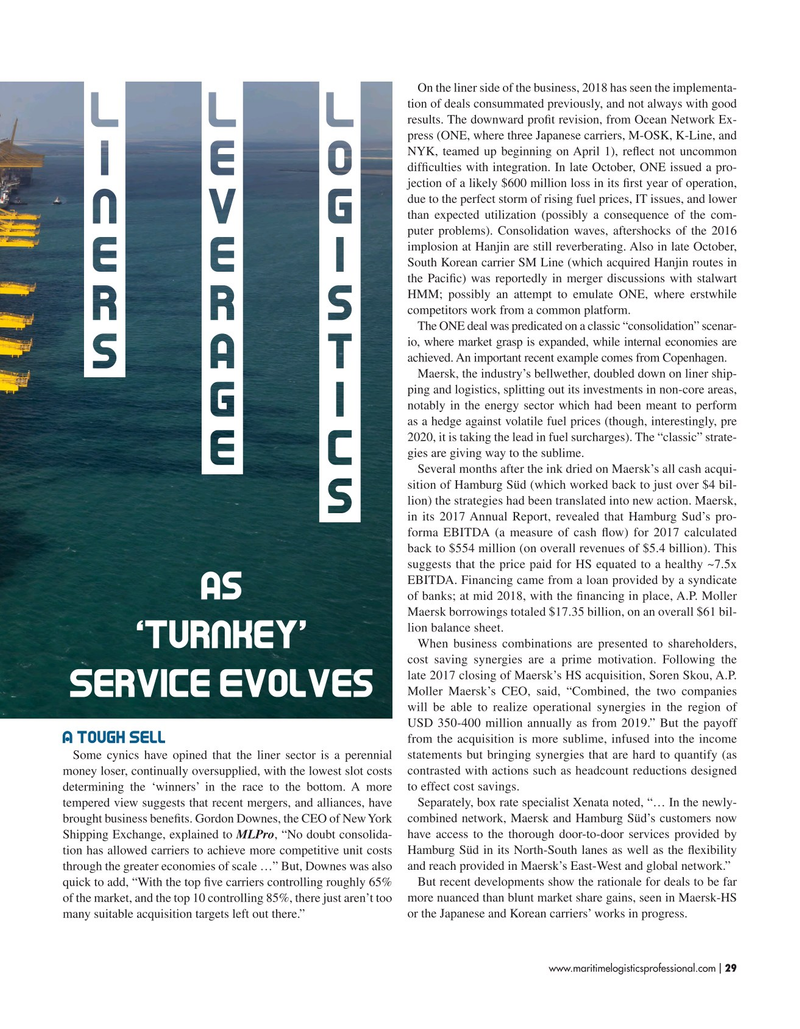
Page 29: of Maritime Logistics Professional Magazine (Sep/Oct 2018)
Liner Shipping & Logistics
Read this page in Pdf, Flash or Html5 edition of Sep/Oct 2018 Maritime Logistics Professional Magazine
On the liner side of the business, 2018 has seen the implementa- tion of deals consummated previously, and not always with good results. The downward proft revision, from Ocean Network Ex- press (ONE, where three Japanese carriers, M-OSK, K-Line, and
NYK, teamed up beginning on April 1), refect not uncommon diffculties with integration. In late October, ONE issued a pro- jection of a likely $600 million loss in its frst year of operation, due to the perfect storm of rising fuel prices, IT issues, and lower than expected utilization (possibly a consequence of the com- puter problems). Consolidation waves, aftershocks of the 2016 implosion at Hanjin are still reverberating. Also in late October,
South Korean carrier SM Line (which acquired Hanjin routes in the Pacifc) was reportedly in merger discussions with stalwart
HMM; possibly an attempt to emulate ONE, where erstwhile competitors work from a common platform.
The ONE deal was predicated on a classic “consolidation” scenar- io, where market grasp is expanded, while internal economies are achieved. An important recent example comes from Copenhagen.
Maersk, the industry’s bellwether, doubled down on liner ship- ping and logistics, splitting out its investments in non-core areas, notably in the energy sector which had been meant to perform as a hedge against volatile fuel prices (though, interestingly, pre 2020, it is taking the lead in fuel surcharges). The “classic” strate- gies are giving way to the sublime.
Several months after the ink dried on Maersk’s all cash acqui- sition of Hamburg Süd (which worked back to just over $4 bil- lion) the strategies had been translated into new action. Maersk, in its 2017 Annual Report, revealed that Hamburg Sud’s pro- forma EBITDA (a measure of cash fow) for 2017 calculated back to $554 million (on overall revenues of $5.4 billion). This suggests that the price paid for HS equated to a healthy ~7.5x
EBITDA. Financing came from a loan provided by a syndicate of banks; at mid 2018, with the fnancing in place, A.P. Moller
Maersk borrowings totaled $17.35 billion, on an overall $61 bil- lion balance sheet.
When business combinations are presented to shareholders, cost saving synergies are a prime motivation. Following the late 2017 closing of Maersk’s HS acquisition, Soren Skou, A.P.
Moller Maersk’s CEO, said, “Combined, the two companies will be able to realize operational synergies in the region of
USD 350-400 million annually as from 2019.” But the payoff from the acquisition is more sublime, infused into the income
A Tough Sell
Some cynics have opined that the liner sector is a perennial statements but bringing synergies that are hard to quantify (as money loser, continually oversupplied, with the lowest slot costs contrasted with actions such as headcount reductions designed determining the ‘winners’ in the race to the bottom. A more to effect cost savings.
tempered view suggests that recent mergers, and alliances, have Separately, box rate specialist Xenata noted, “… In the newly- brought business benefts. Gordon Downes, the CEO of New York combined network, Maersk and Hamburg Süd’s customers now
Shipping Exchange, explained to MLPro, “No doubt consolida- have access to the thorough door-to-door services provided by tion has allowed carriers to achieve more competitive unit costs Hamburg Süd in its North-South lanes as well as the fexibility through the greater economies of scale …” But, Downes was also and reach provided in Maersk’s East-West and global network.” quick to add, “With the top fve carriers controlling roughly 65% But recent developments show the rationale for deals to be far of the market, and the top 10 controlling 85%, there just aren’t too more nuanced than blunt market share gains, seen in Maersk-HS many suitable acquisition targets left out there.” or the Japanese and Korean carriers’ works in progress.
www.maritimelogisticsprofessional.com 29
I

 28
28

 30
30
